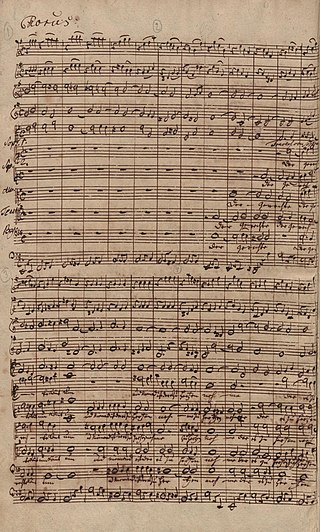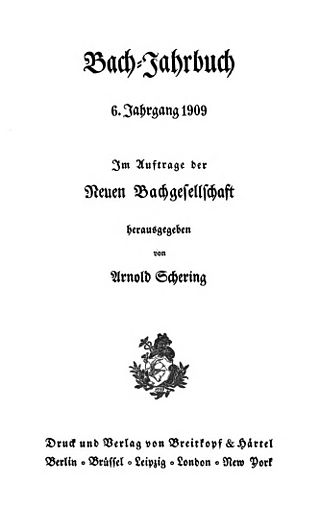Anna Magdalena Bach was a German professional singer and the second wife of Johann Sebastian Bach.

The sonatas and partitas for solo violin are a set of six works composed by Johann Sebastian Bach. They are sometimes referred to in English as the sonatas and partias for solo violin in accordance with Bach's headings in the autograph manuscript: "Partia" was commonly used in German-speaking regions during Bach's time, whereas the Italian "partita" was introduced to this set in the 1879 Bach Gesellschaft edition, having become standard by that time. The set consists of three sonatas da chiesa in four movements and three partitas in dance-form movements. The 2nd Partita is widely known for its Chaconne, considered one of the most masterly and expressive works ever written for solo violin.
"Bist du bei mir, geh ich mit Freuden" is an aria from Gottfried Heinrich Stölzel's opera Diomedes, which was first staged on 16 November 1718. The aria is best known as "Bist du bei mir," BWV 508, a version for voice and continuo found as No. 25 in the 1725 Notebook for Anna Magdalena Bach.
The New Bach Edition (NBE), is the second complete edition of the music of Johann Sebastian Bach, published by Bärenreiter. The name is short for Johann Sebastian Bach (1685–1750): New Edition of the Complete Works. It is a historical-critical edition of Bach's complete works by the Johann Sebastian Bach Institute (Johann-Sebastian-Bach-Institut) in Göttingen and the Bach Archive (Bach-Archiv) in Leipzig,

Angenehmes Wiederau, freue dich in deinen Auen, BWV 30.1, is a 1737 secular cantata by Johann Sebastian Bach, on a libretto by Christian Friedrich Henrici (Picander). Bach reused some of its music in later works, including Freue dich, erlöste Schar, BWV 30.2, one of his church cantatas, which was nearly entirely modelled after the secular composition.
Alfred Dürr was a German musicologist. He was a principal editor of the Neue Bach-Ausgabe, the second edition of the complete works of Johann Sebastian Bach.
Werner Neumann was a German musicologist. He founded the Bach-Archiv Leipzig on 20 November 1950 and was a principal editor of the Neue Bach-Ausgabe, the second edition of the complete works of Johann Sebastian Bach.
The Johann Sebastian Bach Institute was an institute dedicated to Johann Sebastian Bach in Göttingen, Germany. It was founded in 1951 as one of two institutes preparing the New Bach Edition, the second complete edition of the composer's works. The partner organisation was the Leipzig Bach Archive in what was then East Germany on the other side of the Iron Curtain from Göttingen. The new edition met rigorous scientific requirements and at the same time served musical practice.

Wer ist der, so von Edom kömmt is a pasticcio Passion oratorio based on compositions by Carl Heinrich Graun, Georg Philipp Telemann, Johann Sebastian Bach and others. The pasticcio was assembled around 1750.

BWV Anh., abbreviation of Bach-Werke-Verzeichnis Anhang, is a list of lost, doubtful, and spurious compositions by, or once attributed to, Johann Sebastian Bach.

The first major biographies of Johann Sebastian Bach, including those by Johann Nikolaus Forkel and Philipp Spitta, were published in the 19th century. Many more were published in the 20th century by, among others, Albert Schweitzer, Charles Sanford Terry, Christoph Wolff and Klaus Eidam.

"An Wasserflüssen Babylon" is a Lutheran hymn by Wolfgang Dachstein, which was first published in Strasbourg in 1525. The text of the hymn is a paraphrase of Psalm 137. Its singing tune, which is the best known part of the hymn and Dachstein's best known melody, was popularised as the chorale tune of Paul Gerhardt's 17th-century Passion hymn "Ein Lämmlein geht und trägt die Schuld". With this hymn text, Dachstein's tune is included in the Protestant hymnal Evangelisches Gesangbuch.
The Dietel manuscript, D-LEb Peters Ms. R 18, also known as the Dietel Collection and, in German, Choralsammlung Dietel, is the oldest extant manuscript with a large collection of four-part chorales by Johann Sebastian Bach. It contains 149 of Bach's chorale harmonisations and originated around 1735. The music in the manuscript was copied by Johann Ludwig Dietel, one of Bach's pupils from the Thomasschule.
Hans-Joachim Schulze is a German musicologist, a Bach scholar who served as the director of the Bach Archive in Leipzig from 1992 to 2000. With Christoph Wolff, he was editor of the Bach-Jahrbuch from 1975 to 2000. He published an introduction to all cantatas by Johann Sebastian Bach in 2006.

The Bach-Jahrbuch is an annual publication related to the composer Bach. It is published in German by the Neue Bachgesellschaft in Leipzig. It is the most respected publication for international Bach research.
Georg von Dadelsen was a German musicologist, who taught at the University of Hamburg and the University of Tübingen. He focused on Johann Sebastian Bach, his family and his environment, and the chronology of his works. As director of the Johann Sebastian Bach Institute in Göttingen, he influenced the Neue Bach-Ausgabe (NBA), the second complete edition of Bach's works.
Werner Felix was a German music historian and Bach scholar. He was rector of the Hochschule für Musik Franz Liszt, Weimar and the University of Music and Theatre Leipzig as well as president of the Chopin-Gesellschaft of the DDR.
Peter Wollny is a German musicologist, a Bach scholar who has served the Bach Archive Leipzig beginning in 1993, and as its director from 2014. Wollny has contributed to the Neue Bach-Ausgabe, and has been an editor of Carl Philipp Emanuel Bach: The Complete Works. He has been professor at the University of Leipzig, and teaching internationally. He received an honorary doctorate from the University of Uppsala.









